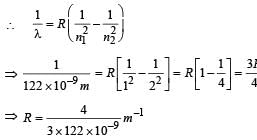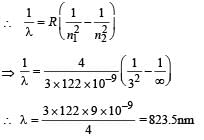JEE Exam > JEE Questions > The largest wavelength in the ultraviolet reg...
Start Learning for Free
The largest wavelength in the ultraviolet region of the hydrogen spectrum is 122 nm. The smallest wavelength in the infrared region of the hydrogen spectrum (to the nearest integer) is
- a)802 nm
- b)823 nm
- c)1882 nm
- d)1648 nm
Correct answer is option 'B'. Can you explain this answer?
| FREE This question is part of | Download PDF Attempt this Test |
Verified Answer
The largest wavelength in the ultraviolet region of the hydrogen spect...
The smallest frequency and largest wavelength in ultraviolet region will be for transition of electron from orbit 2 to orbit 1.

The highest frequency and smallest wavelength for infrared region will be for transition of electron from ∞ to 3rd orbit.

Most Upvoted Answer
The largest wavelength in the ultraviolet region of the hydrogen spect...
The hydrogen spectrum is a series of lines that are produced when the electrons in hydrogen atoms transition between different energy levels. These transitions result in the emission or absorption of light at specific wavelengths.
The ultraviolet region of the hydrogen spectrum corresponds to transitions where the electrons move from higher energy levels to lower energy levels. The largest wavelength in this region corresponds to the smallest energy difference between the two levels involved in the transition. In other words, it represents the transition with the lowest energy.
The formula to calculate the wavelength of a transition in the hydrogen spectrum is given by the Rydberg formula:
1/λ = R_H * (1/n1^2 - 1/n2^2)
Where λ is the wavelength, R_H is the Rydberg constant for hydrogen (approximately 1.097 * 10^7 m^-1), and n1 and n2 are the principal quantum numbers of the initial and final energy levels, respectively.
To find the largest wavelength in the ultraviolet region, we need to find the transition with the lowest energy. This corresponds to the transition with the smallest difference in the values of n1 and n2. Since the smallest possible value for n2 is 1, we need to find the largest possible value for n1.
The largest possible value for n1 can be determined by using the fact that the energy of an electron in a hydrogen atom is given by the equation:
E = -13.6 eV / n^2
Where E is the energy and n is the principal quantum number. Setting E equal to zero (since we are looking for the highest energy level), we can solve for n:
0 = -13.6 eV / n^2
n^2 = 13.6 eV / 0
n^2 = ∞
n = ∞
Therefore, the largest possible value for n1 is infinity.
Plugging in the values into the Rydberg formula, we get:
1/λ = 1.097 * 10^7 m^-1 * (1/infinity^2 - 1/1^2)
1/λ = 1.097 * 10^7 m^-1 * (0 - 1)
1/λ = -1.097 * 10^7 m^-1
λ = -1/(-1.097 * 10^7 m^-1)
λ = 9.11 * 10^-8 m
λ = 91.1 nm
Therefore, the largest wavelength in the ultraviolet region of the hydrogen spectrum is 91.1 nm, which is less than the given value of 122 nm.
Moving on to the infrared region of the hydrogen spectrum, this corresponds to transitions where the electrons move from lower energy levels to higher energy levels. The smallest wavelength in this region corresponds to the transition with the highest energy difference between the two levels involved in the transition. In other words, it represents the transition with the highest energy.
Using the Rydberg formula, we can calculate the smallest wavelength in the infrared region by finding the transition with the highest energy difference. This corresponds to the transition with the largest difference in the values of n1 and n2. Since the smallest possible value for n1 is 1, we need to find the largest possible value for n2.
Again, the largest possible value for n2 can be determined by using the fact that the energy of an electron in
The ultraviolet region of the hydrogen spectrum corresponds to transitions where the electrons move from higher energy levels to lower energy levels. The largest wavelength in this region corresponds to the smallest energy difference between the two levels involved in the transition. In other words, it represents the transition with the lowest energy.
The formula to calculate the wavelength of a transition in the hydrogen spectrum is given by the Rydberg formula:
1/λ = R_H * (1/n1^2 - 1/n2^2)
Where λ is the wavelength, R_H is the Rydberg constant for hydrogen (approximately 1.097 * 10^7 m^-1), and n1 and n2 are the principal quantum numbers of the initial and final energy levels, respectively.
To find the largest wavelength in the ultraviolet region, we need to find the transition with the lowest energy. This corresponds to the transition with the smallest difference in the values of n1 and n2. Since the smallest possible value for n2 is 1, we need to find the largest possible value for n1.
The largest possible value for n1 can be determined by using the fact that the energy of an electron in a hydrogen atom is given by the equation:
E = -13.6 eV / n^2
Where E is the energy and n is the principal quantum number. Setting E equal to zero (since we are looking for the highest energy level), we can solve for n:
0 = -13.6 eV / n^2
n^2 = 13.6 eV / 0
n^2 = ∞
n = ∞
Therefore, the largest possible value for n1 is infinity.
Plugging in the values into the Rydberg formula, we get:
1/λ = 1.097 * 10^7 m^-1 * (1/infinity^2 - 1/1^2)
1/λ = 1.097 * 10^7 m^-1 * (0 - 1)
1/λ = -1.097 * 10^7 m^-1
λ = -1/(-1.097 * 10^7 m^-1)
λ = 9.11 * 10^-8 m
λ = 91.1 nm
Therefore, the largest wavelength in the ultraviolet region of the hydrogen spectrum is 91.1 nm, which is less than the given value of 122 nm.
Moving on to the infrared region of the hydrogen spectrum, this corresponds to transitions where the electrons move from lower energy levels to higher energy levels. The smallest wavelength in this region corresponds to the transition with the highest energy difference between the two levels involved in the transition. In other words, it represents the transition with the highest energy.
Using the Rydberg formula, we can calculate the smallest wavelength in the infrared region by finding the transition with the highest energy difference. This corresponds to the transition with the largest difference in the values of n1 and n2. Since the smallest possible value for n1 is 1, we need to find the largest possible value for n2.
Again, the largest possible value for n2 can be determined by using the fact that the energy of an electron in
Attention JEE Students!
To make sure you are not studying endlessly, EduRev has designed JEE study material, with Structured Courses, Videos, & Test Series. Plus get personalized analysis, doubt solving and improvement plans to achieve a great score in JEE.

|
Explore Courses for JEE exam
|

|
Similar JEE Doubts
The largest wavelength in the ultraviolet region of the hydrogen spectrum is 122 nm. The smallest wavelength in the infrared region of the hydrogen spectrum (to the nearest integer) isa)802 nmb)823 nmc)1882 nmd)1648 nmCorrect answer is option 'B'. Can you explain this answer?
Question Description
The largest wavelength in the ultraviolet region of the hydrogen spectrum is 122 nm. The smallest wavelength in the infrared region of the hydrogen spectrum (to the nearest integer) isa)802 nmb)823 nmc)1882 nmd)1648 nmCorrect answer is option 'B'. Can you explain this answer? for JEE 2024 is part of JEE preparation. The Question and answers have been prepared according to the JEE exam syllabus. Information about The largest wavelength in the ultraviolet region of the hydrogen spectrum is 122 nm. The smallest wavelength in the infrared region of the hydrogen spectrum (to the nearest integer) isa)802 nmb)823 nmc)1882 nmd)1648 nmCorrect answer is option 'B'. Can you explain this answer? covers all topics & solutions for JEE 2024 Exam. Find important definitions, questions, meanings, examples, exercises and tests below for The largest wavelength in the ultraviolet region of the hydrogen spectrum is 122 nm. The smallest wavelength in the infrared region of the hydrogen spectrum (to the nearest integer) isa)802 nmb)823 nmc)1882 nmd)1648 nmCorrect answer is option 'B'. Can you explain this answer?.
The largest wavelength in the ultraviolet region of the hydrogen spectrum is 122 nm. The smallest wavelength in the infrared region of the hydrogen spectrum (to the nearest integer) isa)802 nmb)823 nmc)1882 nmd)1648 nmCorrect answer is option 'B'. Can you explain this answer? for JEE 2024 is part of JEE preparation. The Question and answers have been prepared according to the JEE exam syllabus. Information about The largest wavelength in the ultraviolet region of the hydrogen spectrum is 122 nm. The smallest wavelength in the infrared region of the hydrogen spectrum (to the nearest integer) isa)802 nmb)823 nmc)1882 nmd)1648 nmCorrect answer is option 'B'. Can you explain this answer? covers all topics & solutions for JEE 2024 Exam. Find important definitions, questions, meanings, examples, exercises and tests below for The largest wavelength in the ultraviolet region of the hydrogen spectrum is 122 nm. The smallest wavelength in the infrared region of the hydrogen spectrum (to the nearest integer) isa)802 nmb)823 nmc)1882 nmd)1648 nmCorrect answer is option 'B'. Can you explain this answer?.
Solutions for The largest wavelength in the ultraviolet region of the hydrogen spectrum is 122 nm. The smallest wavelength in the infrared region of the hydrogen spectrum (to the nearest integer) isa)802 nmb)823 nmc)1882 nmd)1648 nmCorrect answer is option 'B'. Can you explain this answer? in English & in Hindi are available as part of our courses for JEE.
Download more important topics, notes, lectures and mock test series for JEE Exam by signing up for free.
Here you can find the meaning of The largest wavelength in the ultraviolet region of the hydrogen spectrum is 122 nm. The smallest wavelength in the infrared region of the hydrogen spectrum (to the nearest integer) isa)802 nmb)823 nmc)1882 nmd)1648 nmCorrect answer is option 'B'. Can you explain this answer? defined & explained in the simplest way possible. Besides giving the explanation of
The largest wavelength in the ultraviolet region of the hydrogen spectrum is 122 nm. The smallest wavelength in the infrared region of the hydrogen spectrum (to the nearest integer) isa)802 nmb)823 nmc)1882 nmd)1648 nmCorrect answer is option 'B'. Can you explain this answer?, a detailed solution for The largest wavelength in the ultraviolet region of the hydrogen spectrum is 122 nm. The smallest wavelength in the infrared region of the hydrogen spectrum (to the nearest integer) isa)802 nmb)823 nmc)1882 nmd)1648 nmCorrect answer is option 'B'. Can you explain this answer? has been provided alongside types of The largest wavelength in the ultraviolet region of the hydrogen spectrum is 122 nm. The smallest wavelength in the infrared region of the hydrogen spectrum (to the nearest integer) isa)802 nmb)823 nmc)1882 nmd)1648 nmCorrect answer is option 'B'. Can you explain this answer? theory, EduRev gives you an
ample number of questions to practice The largest wavelength in the ultraviolet region of the hydrogen spectrum is 122 nm. The smallest wavelength in the infrared region of the hydrogen spectrum (to the nearest integer) isa)802 nmb)823 nmc)1882 nmd)1648 nmCorrect answer is option 'B'. Can you explain this answer? tests, examples and also practice JEE tests.

|
Explore Courses for JEE exam
|

|
Suggested Free Tests
Signup for Free!
Signup to see your scores go up within 7 days! Learn & Practice with 1000+ FREE Notes, Videos & Tests.
























